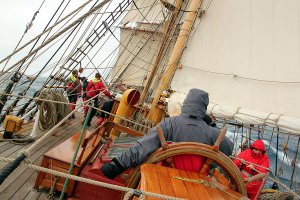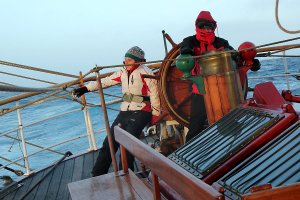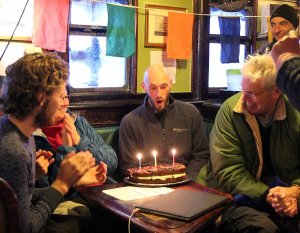Arto's Blog
| « Green and lively South Georgia | The end of the Antarctic summer » |
Towards South Georgia: Seasickness hits again
Posted: 2015-08-31 22:24:00, Categories: Travel, Antarctica, Sailing, South Georgia, 797 words (permalink)After one week of wonderful landings in Antarctica, we started
sailing towards South Georgia, a subantarctic island about 800
nautical miles north-east from the Antarctic Peninsula. The wind was
against us, and Bark Europa like most old tall ships cannot sail in
a very sharp angle against the wind. Therefore we headed first
north-west and later turned eastwards towards our destination,
catching a more favorable wind.
During the first day we had waves coming from several directions
and the ship moved a lot, both back and forth and from side to
side. It didn't take long before Sandra and I were seasick again. We
were not alone — more than half of the people on board got
sick, including several members of the crew.
Some more experienced sailors recommended not take any pills:
it might be worse in the beginning but be over sooner. We followed their advice,
hoping to get used to the movement in 1-3 days, as most
of the people did. Unfortunately we both didn't, and struggled for
the whole week until South Georgia. It was a challenge not
only physically but psychologically, trying to keep the mood up and
enjoy the otherwise exciting trip.
How is it then to be seasick? I would describe it as similar to
having a stomach flu, but with a couple of differences. Firstly,
seasickness doesn't take the feeling of hunger away. So you might
throw up several times but still feel hungry and willing to eat.
That is actually good, it's healthy to drink and try to eat
something even if the food wouldn't stay inside, but it's a strange
feeling. Secondly, the symptoms are very much dependent on what you
do on the ship. General advice such as "go out, watch the
waves, don't look down and read a book" is easy to give and to
find, but eventually you have to experiment yourself to find out
what you can do and which activities are better to avoid. The
feedback comes quickly, it might be unpleasant but not deadly. ;-)
The program on Bark Europa doesn't let anyone become bored during
the sailing days. Everyone is expected to take part in the watch
system where the day is divided in three watches: 12 to 4, 4 to 8
and 8 to 12. During the Antarctica – South Georgia leg Sandra and I
were in the 4 to 8 watch, which means that our daily working times
were from 4 to 8 am and from 4 to 8 pm. Each four hours included
usually 3 half an hour shifts of being either at the lookout
(watching the sea in front of the ship and reporting any obstacles
or potential dangers) or at the helm (steering the ship to a
direction given by the captain). The rest of the time was being
available to help on the deck — which might mean a lot of rope
pulling on a busy day or night, or an opportunity to take it easy
and socialize at the deckhouse when the wind is steady and there is
less to do. Cleaning and cooking was taken care by the permanent
crew, although we did some potato peeling and other
minor tasks.
In addition to the watches and practical sailing lessons there was
a very interesting educational program, consisting of lectures and
documentaries about sailing, navigation, oceanography, history of
polar exploration, polar ecosystems and wildlife in the polar
regions. Each lecture was normally repeated at least once so that
everybody got a chance to attend outside the hours of their watch.
Our guides Jordi and Eduardo were both knowledgeable and
enthusiastic about their areas of speciality, which made the lectures
a pleasure to follow. There were also a few extra lectures given by
members of the voyage crew (passengers) who had something
interesting to share, and more leisurely activities such as playing
card games or watching a movie. And every day someone had a
birthday it was celebrated together at dinner time.
We participated in the watches, lectures and activities as much as
we could. The wind got more steady and our feeling a bit better
towards the end of the passage, but after seven and a half days on
sea we were happy to see the South Georgian coastline. Like in
Antarctica, as soon as we arrived in the more protected waters, our
seasickness was gone as soon as it had started. A new world of
mountains, rocks, snow, ice and wildlife was waiting for us, but
this time there was also a lot of green to see. We would soon land
and have a chance to walk on the Tussock grass.
No feedback yet

Copyright Arto Teräs <ajt@iki.fi>, licensed under the Creative Commons Attribution-Share Alike 3.0 Unported License. (Unless otherwise mentioned in individual photos or other content.)






